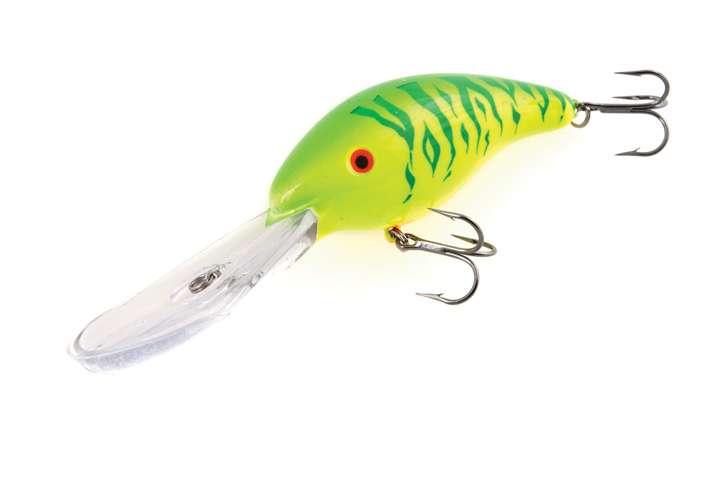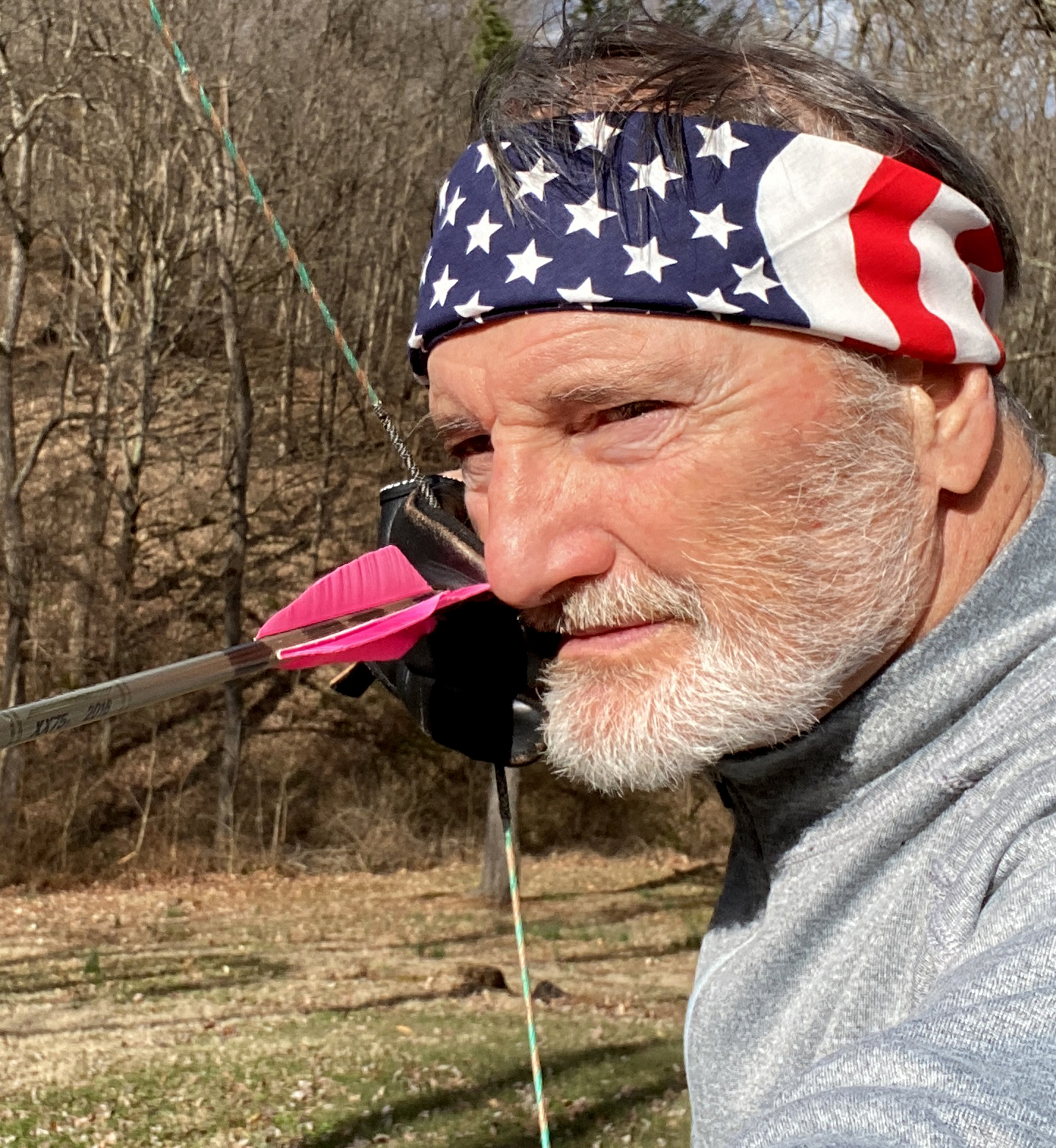
It’s no easy feat to build a crankbait that breaks the 20-foot depth barrier. Mann’s 30+ and Luhr Jensen’s 3/4-ounce Hot Lips Express have been doing this for years, but they’ve had few serious challengers — until now. View photos of the Superdeep All-Stars.
Today, there are more than a dozen “supersonic” crankers that dive 20 feet or more. Why do you need them? Timmy Horton has the answer.
“The key to fishing diving crankbaits is hitting the bottom,” Horton says. “If you’re missing the bottom by 1 foot, you’re missing it by a mile.”
Horton claims that bass are beginning to hold deeper at places like Pickwick and Kentucky lakes. The reason may be fishing pressure and the fact that many aging reservoirs are getting clearer. Whatever the case, it takes a superdeep diver to reach summertime bass in their deep-water sanctuaries.
When Horton casts Bomber’s Deep Fat Free BD8F on 10-pound fluorocarbon line, he claims that he clips the bottom in 20 feet “all day long.” The BD8F comes in rattling and nonrattling models. Horton ties on the nonrattling version 70 percent of the time. He prefers to sneak a crankbait into the strike zone.
“It’s suddenly in their face, and they have a split second to react,” Horton says. “That reaction is often a strike.”
BIG BANG THEORY
Why not fish something that reaches the depths without the physical exertion required of deep cranking? A football jig and a Carolina rig are just a few of many other baits that appeal to deep bass.
Unfortunately for your aching muscles, the heaviest bass often prefer a crankbait. Bassmaster veteran and Elite Series pro Paul Elias has experienced this many times. One instance happened during a postspawn tournament at Lake Guntersville.
Elias had found a school of bass on a roadbed in 22 feet of water. He could catch 2-pounders at will on a jig or a Carolina rig, but nothing bigger. A Mann’s 30+, which he has been fishing for more than 15 years, got fewer bites, but it duped 3- to 5-pounders.
“You’re usually going to get bigger bites anytime you throw a big crankbait like Mann’s 30+,” Elias said.
TOTAL SYSTEM
It is essential that you make long casts to give a deep crankbait room to get down and wiggle through the strike zone. This is one reason Kevin VanDam dotes on the 6XD, which he designed for Strike King.
“I balanced that crankbait so you can throw it a mile,” he said.
VanDam also stresses that the 6XD is part of a “system” he devised for optimum deep cranking. It consists of a 7-foot, 10-inch Quantum Tour KVD Cranking Casting Rod, matched with a 5.3:1 gear ratio Quantum Tour KVD Cranking Classic Casting reel and 12-pound fluorocarbon line.
“I don’t have to throw as hard with that rod to make a long cast,” VanDam says. “And the low-gear ratio reel makes cranking easier.”
Whatever brands of tackle other Elite Series pros rely on for deep cranking, nearly all of them have a similar system comprised of a long rod, a low gear ratio baitcasting reel and fluorocarbon line.
The Strike King 6XD comes in rattling and nonrattling versions. VanDam usually works over the bass with the rattler first. When they stop biting it, he can often recharge them with the nonrattling model, which he claims runs 1 foot deeper.
“I never leave a school of bass without throwing the silent 6XD at them,” VanDam says.
VanDam used this one-two 6XD punch during an Elite Series tournament at Kentucky Lake in June 2010. He dredged up a winning total of 92-pounds, 5-ounces of bass that were holding 18 to 25 feet deep.
GRINDING BASS
Elite Series pro John Crews, of Virginia, designed Spro’s 1-ounce Little John DD to tag bottom 20 feet deep with 10-pound fluorocarbon line. However, he doesn’t use it exclusively for superdeep bass. During an Elite Series tournament at Lake Guntersville in May 2010, he cranked up more than 100 postspawn bass a day from main river drops that were 12 feet deep. His four-day total of 92 pounds, 11 ounces earned him a third-place finish. “I was just grinding that crankbait over the bottom,” Crews says.
The bill on the Little John angles down slightly, points out Crews. This prevents the bait from kicking out and losing traction when it’s rooting the bottom. A relatively fast 6.4:1 Pinnacle Optimus X baitcasting reel helps Crews maintain an upbeat retrieve that can trigger a reflex strike and fire up a school of bass.
“I use 12-pound Vicious Fluorocarbon 95 percent of the time when I’m grinding a crankbait,” Crews said. “It holds up well and has the strength to boat-swing 3 1/2-pound bass.”
TELEPATHY
Elite Series pro Jason Quinn has aptly demonstrated his crankbait skills on the Elite Series trail, especially with Luhr Jensen’s Hot Lips Express.
“I’ve been fishing the Hot Lips Express since I grew up,” the South Carolinian says. “It’s the deepest diving crankbait on the market, period!”
Luhr Jensen claims that this 3/4-ounce cranker will get down 24 feet. Quinn “comfortably” touches bottom with it 22 to 23 feet deep on 10-pound Trilene 100 Percent Fluorocarbon.
Quinn slings the Hot Lips with a 7-foot, 11-inch Duckett Micro Magic rod and a 5.4:1 gear ratio Abu Garcia Revo Winch reel. When the bait hits the water, he alternately sweeps the rod sideways and then reels up the slack. This tactic lets him feel the instant the crankbait touches bottom and every stump and rock it bumps into.
“If I wind a big crankbait straight in, I can’t tell when it hits something,” Quinn says.
The most unique feature of the Hot Lips Express is its wide, tri-lobed bill. Besides forcing the bait deep, the big bill allows the crankbait’s body to be considerably smaller than other superdeep divers. This reduces the leverage bass can put on the hooks and results in fewer lost fish, Quinn claims.
“When the Hot Lips is down there walking on the bottom, that batwing bill deflects off stuff better than a regular bill,” Quinn says. “It triggers more bites from bigger bass.”
Originally published May 2012
B.A.S.S. Members can read Bassmaster Magazine online via Digital Bassmaster.





